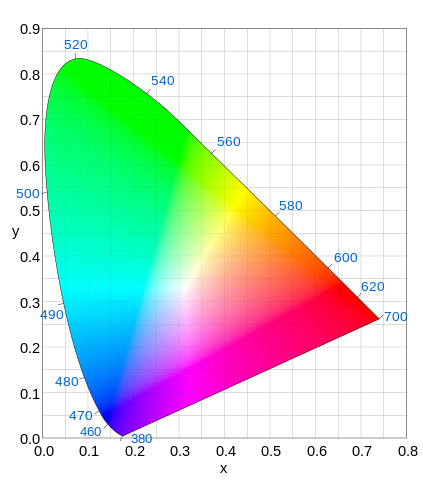 |
This is a file from the Wikimedia Commons. Information from its description page there is shown below.
Commons is a freely licensed media file repository. You can help.
|
Summary
| Description |
Illustration of the CIE 1931 colour space. This is a vectorized version of Image:CIExy1931.png by User:PAR. The spectral colours are embedded as a JPEG raster image with SVG blur applied to allow scaling to any size. From the description of Image:CIExy1931.png:
The colors for this diagram were generated using the RGB colour space in en:Adobe photoshop. The transformation from xy chromaticity coordinates was done using the en:sRGB color space specification on the [X,Y,Z]=[x,y,1-x-y] tristimulus values, then multiplying by a constant so that one of the R, G, or B values was maximized. Assuming that one's monitor converts Adobe photoshop RGB according to the sRGB colour space (probably a good assumption) then, within the sRGB gamut, the chromaticities are correct, but are incorrect outside the gamut. (See the sRGB article for a description of the sRGB gamut). The process of maximizing the value of R, G, or B results in a distinct 3-pointed star in the diagram, centered at the D65 white point. This is because, although the chromaticities are correct, the luminosities (brightness values) are not equal across the diagram. If the luminosities were all made equal, then the entire diagram would be rather dark, since pure blue has a low luminosity. Any attempt to equalize luminosity to remove the star will reduce the overall luminosity of the diagram, and the star will not completely disappear until the diagram is very dark. Alternatively, we could blur the colors to get rid of the star, which would give incorrect chromaticities. I have opted for correct chromaticities at maximum brightness, thus the presence of the star.
|
| Date |
13 July 2007 |
| Source |
Own work |
| Author |
Sakurambo |
XYZ → RGB conversion
The colour values in the embedded bitmap image were calculated based on pseudocode available at easyrgb.com
Licensing
I, Sakurambo, the copyright holder of this work, hereby publishes it under the following licenses:
 |
Permission is granted to copy, distribute and/or modify this document under the terms of the GNU Free Documentation License, Version 1.2 or any later version published by the Free Software Foundation; with no Invariant Sections, no Front-Cover Texts, and no Back-Cover Texts. A copy of the license is included in the section entitled GNU Free Documentation License. http://www.gnu.org/copyleft/fdl.htmlGFDLGNU Free Documentation Licensetruetrue
|
You may select the license of your choice.
|
File usage
The following pages on Schools Wikipedia link to this image (list may be incomplete):
This file contains additional information, probably added from the digital camera or scanner used to create or digitize it. If the file has been modified from its original state, some details may not fully reflect the modified file.
Wikipedia for Schools is one of SOS Children's many educational projects. SOS Childrens Villages is an international children's charity, providing a good home and loving family to thousands of children who have lost their parents. We also work with communities to help vulnerable families stay together and raise children in the best possible environment. You can help by sponsoring a child.



